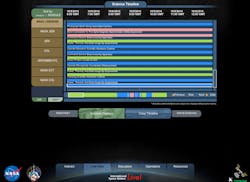Industry is taking a serious look at the Internet of Things. After all, the sensors, networks, databases and data analysis software needed for IoT applications are already deployed in many industrial sectors, and machine-to-machine (M2M) connectivity is already well underway. As Automation World Editorial Director David Greenfield says in a recent post about Intel’s use of IoT technology to improve semiconductor manufacturing, “Judging by the increasing speed with which real world IoT applications in manufacturing are being reported, it’s clear that the concept has legs.” Now, apparently, the Internet of Things concept also has thrusters and a planetary orbit.
A press release from The Center for the Advancement of Science in Space (CASIS), which manages the U.S. National Laboratory on the International Space Station (ISS), provided an overview of seven proposed experiments to be conducted on the Space Station. Among them is the test of a payload processor whose results could lead to better sensors and machine communications in commercial/industrial applications.
According to CASIS, “Drs. John Samson, Jr. and Benjamin Malphrus from Morehead State University (Morehead, KY) in conjunction with Honeywell Aerospace (Clearwater, FL) will build and test a small, low-power, high-performance Dependable Multiprocessor (DM) Payload Processor on ISS. Such DM Payload processors are applicable to a wide variety of commercial applications including space-based machine-to-machine network communications, global tracking, and remote sensing.”
Such “announced unsolicited investigations” are ISS projects that do not involve targeted solicitation for grants. Instead, any U.S. researcher, academic institution, or commercial organization can submit a white paper describing an experiment that uses the unique environment of the ISS National Lab for Earth benefit. In some instances, CASIS can provide funding for unsolicited proposals based on scientific merit and potential benefit to the American taxpayer.
Many industrial technologies have been adapted from or tested in outer space applications. Wireless access points from industrial automation vendor Moxa Americas, for example, are enabling communication around the ISS. The Remote Sensing division of ABB Inc. is leading research to develop a new industrial sensor by providing the technology to study planetary rocks from a Mars or Moon Rover. The federal government supplied $2 million for the sensor’s development, with ABB providing the remaining $6 million. (Learn more in Automation World’s article, “It Came from Outer Space…”)
“Through this wide array of unsolicited investigations, CASIS continues in its mission to not only utilize the ISS National Laboratory to its fullest capacity but also bring about novel research inquiry,” said CASIS Chief Operating Officer Duane Ratliff. “These projects represent a broad range of studies that can potentially yield groundbreaking results.”
Other proposed ISS experiments include Jeff Strahan of Milliken & Company (Spartanburg, SC) evaluating flame retardant and/or resistant (FR) textiles as a mode of personal protection from fire-related hazards. “Studying FR behavior of different materials in microgravity will aid in better designs for future FR textiles and benefit those who wear FR protective apparel such as military personnel and civilian workers in the electrical and energy industries,” said Ratliff.
The oil & gas industry has shown some of the biggest interest in IoT technology, particularly in light of recent sensor and wireless-communications advances. At its Emerson Exchange 2014 conference, Emerson Process Management referenced a number of its oil & gas customers when talking about extending what it does for process sensing to such concerns as corrosion, energy consumption, health and safety, and the environment.
“Some 36 percent of a typical refinery maintenance budget is spent on corrosion remediation and repairs,” said Peter Zornio, chief strategic officer at Emerson Process Management. “The industrial sector’s lifecycle energy use could improve by 50 percent [with the use of pervasive sensing.] Together with strategic interpretation, the data [from advanced sensors] can be transformed into actionable information”
Emerson might want to contact Lauren Thompson from A-76 Technologies (Houston, TX), the first CASIS awardee from the oil and gas industry. Thompson plans to test a line of new corrosion inhibitors and lubricants in the harsh environment of space. According to CASIS, “The unique challenges of exposure to the space environment will demonstrate performance under extreme conditions that accelerate material degradation. Metals coated with A-76 products (planned for future use in preventing corrosion in oil and gas lines on Earth) will be exposed to space using the ISS NanoRacks external platform.”
No word on whether Thompson is using advanced sensors and wireless communications to make her measurements and report her findings.
Note: And in terms of real-time communications, live streaming video from the International Space Station is available online at: http://www.ustream.tv/channel/live-iss-stream. It includes internal views when the crew is on-duty and Earth views at other times. The video is accompanied by audio of conversations between the crew and Mission Control.

